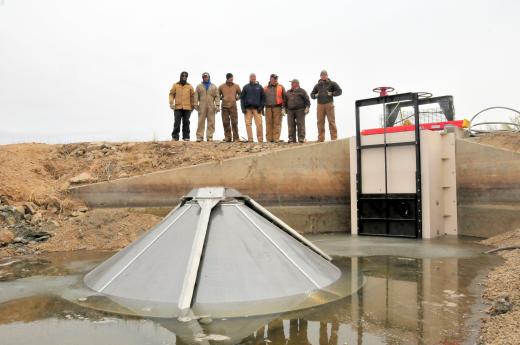The Fish Screen
By Nick Walrath
There are some fisheries problems that seem insurmountable.
Consider the Hamp II irrigation ditch, which is on the Seedskadee National Wildlife Refuge (SNWR) and feeds the extensive wetland system near the Green River in Wyoming. Irrigators turn on the ditch each spring and turn it off each fall, stranding fish that become caught in the system over the summer.
It was known for many years that fish got trapped in the Hamp II ditch. It was not known how big of problem it really was until the Seedskadee Chapter of Trout Unlimited, SNWR, and the Wyoming Game and Fish Department (WGFD) did a fish salvage effort with a handful of people and half a day of work in fall 2012. The alarming number of trapped fish found in the system prompted an increased effort in 2013.
In those two years, project partners rescued piles of fish out of the Hamp II ditch and returned them to the Green River. In a river known for wild browns, seeing nearly 1,000 trapped trout under one year of age—all of them in a small section of ditch—for two years running is alarming.
The problem was larger than we all thought.
When the Hamp II screen project got started, installing a working screen that kept fish out of this ditch seemed like something in a fairy tale. When talking to engineers about the screen, they mentioned big numbers with dollar signs in front of them that stood between us and a fish screen. Although the challenge was intimidating, we knew the Green River fishery was worth the money. But where was the money going to come from? It seemed that this engineering marvel just might be out of our league.
But the Seedskadee Chapter kept pushing. STU and project partners used the numbers of fish gathered in 2012 and 2013 to drive the project forward. The data told the story, and the project gained momentum as funding partners hopped on board.
First, funds came from the WGFD for a survey and design of the screen. From there, more funds came in from the Wyoming Wildlife and Natural Resource Trust, U.S. Fish and Wildlife Service, a WGFD Commissioners big game tag, and private donations.
Quickly those big dollar numbers started to seem not as intimidating anymore. The questions about a fish screen that seemed fairy tale-like were being answered.
In fall 2014, a few weeks after a third pile of fish was returned to the Green River from the final Hamp II fish salvage effort, TU and partners installed a fish screen to keep fish from entering the ditch.
Sometimes a project can seem out of reach, but with communication, drive and partnerships, even fairy tales can come true.
Nick Walrath is Green River project coordinator for Trout Unlimited.


